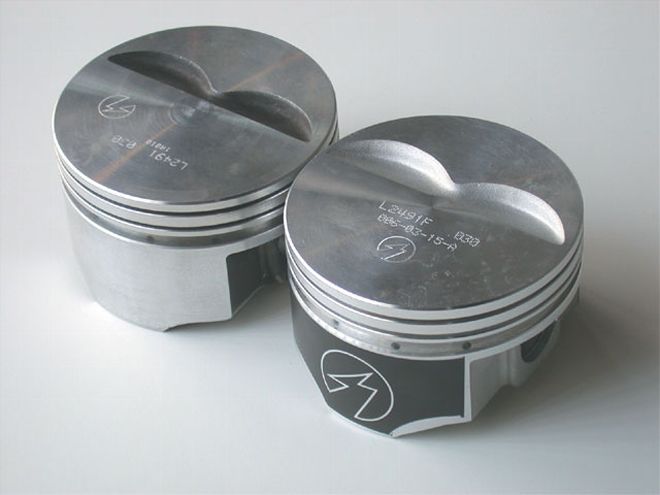

There is no such thing as a TRW piston. There were TRWs years ago, but the piston brand that's sometimes still advertised as TRW is actually from Speed-Pro, a division of Federal-Mogul. It's true that many of the Speed-Pro pistons were the same old parts that became the industry standard of basic forged pistons, and many were made in the same factory that had produced TRWs since the '70s. But now the entire Speed-Pro piston production line has been moved into a new plant, and with that change came a number of significant improvements.
What's fascinating to us are the findings of the R&D study that went into refining these pistons, starting with finite element analysis and sophisticated computer modeling of the effects of temperature, pressure, and inertial loading on the pistons. That information was backed up using temperature and pressure probes on a piston and connecting rod in an actual running engine. These tests gave Speed-Pro engineers a better idea of how the piston shape changes, allowing them to alter the design of the cold pistons to improve their performance in dynamic conditions. Look at the computer models and captions throughout this story to get an idea of those upgrades.
In addition, Speed-Pro's Barry Rabotnick supplied us this list of improvements to the entire line of forgings:
*Pistons sets are now controlled to +/- 2 grams compared to the previous 5-8-gram tolerance
* Skirt-size tolerance has been was tightened by 50 percent, from 0.0010-inch to 0.0005
*Compression-height tolerances were formerly 0.008-0.012 inch; now all the pistons are +/- 0.005
*Ring-land diameter tolerances were reduced from 0.010 to 0.004 inch
*Most of the part numbers have compensated ring grooves, which means the groove root diameter gets larger as the piston od gets larger with overbore sizes
*Top ring lands have been tapered and profiled for better sealing, less dead-air space, and prevention of top-land scuffing in overheated or overloaded engines
*Several applications were redesigned with increased ring-groove radii, improving ring-land strength; some ring widths were also altered
*DurOshield skirt coating has been added to the entire line, including hypereutectics. According to Speed-Pro, this reduces the piston-to-wall coefficient of friction from 0.05 to 0.02 and increases the load-carrying capability
*Skirt profiles have been reshaped for better wall contact and improved wear resistance
*Floating-pin applications use round-wire lock rings instead of flat-wire retainers; see the illustration that shows how this makes the piston stronger
*Piston pins are an improved, tapered, higher strength design for the LW (lightweight) applications available for small Chevys and Fords and big-block Chevys
Also, some designs are lighter, and just by looking at the new pistons you can see that the machine work and surface finish is smoother. This is critical especially in the ring lands, where the often-overlooked sealing surface from the ring to the piston is vastly improved. In some cases, formerly shallow valve pockets have been enlarged to compare to more race-oriented aftermarket pistons. Nevertheless, the old standard of forged pistons not only has a not-very-new name you might not have been aware of, but a whole new level of quality. Check it out next time you order a set.